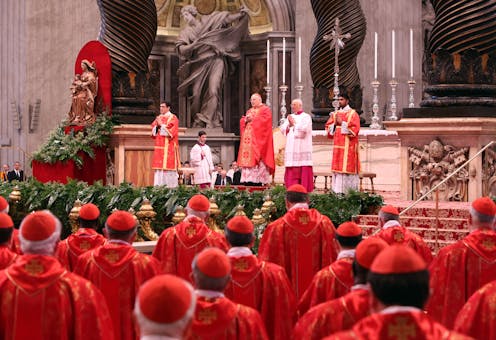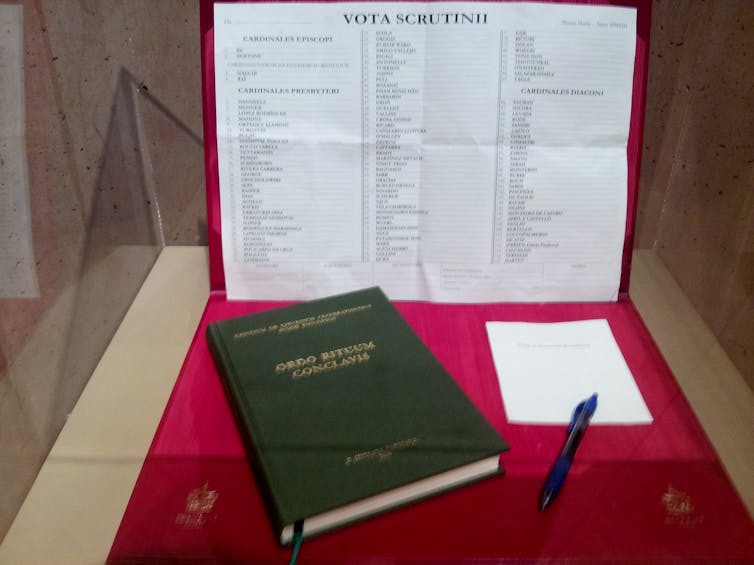How the next pope will be elected – what goes on at the conclave
- The next pope will be chosen through a conclave, a closed-door process where members of the College of Cardinals cast their votes behind locked doors in the Sistine Chapel.
- The conclave is expected to be the most diverse in history, with cardinals from over 90 countries participating, marking a significant shift from centuries past when the College was dominated by Europeans.
- The voting process involves nine randomly selected cardinals running the election, with three “scrutinizers” examining ballots and reading them aloud; a two-thirds majority is required for election, and if not reached, ballots are burned in a stove to signal ongoing deliberations.
- Once a candidate receives enough votes, they are asked to accept their canonical election as Supreme Pontiff, and the ballots are then burned to create white smoke signaling the end of the conclave and the beginning of a new papacy.
- The newly elected pope will then be led to the “Room of Tears” for reflection on the burdens of his position, before being announced from the balcony of St. Peter’s Basilica and delivering their first blessing to the world as the new leader of the Catholic Church.

With the death of Pope Francis, attention now turns to the selection of his successor. The next pope will be chosen in what is called a “conclave,” a Latin word meaning “a room that can be locked up,” or, more simply, “a closed room.”
Members of the College of Cardinals will cast their votes behind the closed and locked doors of the Vatican’s Sistine Chapel, famous for its ceiling frescoes painted by Michelangelo. Distinguished by their scarlet robes, cardinals are chosen by each pope to elect future popes. A cardinal must be under the age of 80 to be eligible to vote in the conclave. Of the 252 members of the College of Cardinals, 138 are currently eligible to elect the new pope.
As a scholar of global Catholicism, I am especially interested in how this will be the most diverse conclave in the history of the Catholic Church.
For many centuries, the College of Cardinals was dominated by Europeans – Italians, in particular. In fact, the first time a non-European cardinal actually cast a ballot in a conclave was only in the 20th century, when Baltimore’s archbishop, James Gibbons, voted in the 1903 papal election. Now, the College of Cardinals has members from over 90 countries, with Francis having appointed nearly 80% of them.
Holding a conclave to elect a pope is a tradition that goes back centuries. The practice was established in 1274 under Pope Gregory X in reaction to the chaos surrounding his own election, which lasted nearly three years. The tradition is old, but the results can be surprising, as when Francis himself was elected in 2013 as the first non-European pope in almost 1,300 years and the first Jesuit pope ever.
The conclave begins
Before the conclave, the College of Cardinals will meet in what are called “general congregations” to discuss issues facing the church. These general congregations will also be an opportunity for new cardinals and those from distant geographical locations to get to know their fellow cardinals.
This can be a time for politicking. In times past, the politicking was rumored to include bribes for votes, as was alleged in the election of Alexander VI, a Borgia pope, in 1492. Nowadays, it is considered to be bad form – and bad luck – for a cardinal to lobby for himself as a candidate. Buying votes by giving money or favors to cardinals is called “simony” and is against church law.
Two to three weeks after the papal funeral, the conclave will begin. The cardinals will first make a procession to the Sistine Chapel, where electronic jamming devices will have been set up to prevent eavesdropping and Wi-Fi and cellphone use. As they file into the chapel, the cardinals will sing, in Latin, the hymn “Come Holy Spirit.” They will then vow on a book of the Gospels to keep the conclave proceedings secret.
After these rituals, the Master of Papal Liturgical Celebrations will say out loud, in Latin, “Extra Omnes,” which means “Everyone Out.” The doors of the Sistine Chapter will then be locked, and the conclave will begin.
The voting process
The cardinals electing the pope will be seated in order of rank.
Usually, the dean of the College of Cardinals is seated in the first position. But the current dean – Cardinal Giovanni Battista Re – is over the eligible voting age and will not participate in the conclave. Instead, this papal election will be led by the Vatican’s secretary of state, Cardinal Pietro Parolin.
When the cardinals have assembled, nine will be chosen at random to run the election, with three of them being “scrutinizers” who will examine the ballots and read them aloud.

Tktru via Wikimedia Commons, CC BY-NC-SA
After writing down the name of their chosen candidate, the cardinals will bring their ballots to the front of the chapel and place them on a plate that is set on top of an urn in front of the scrutinizers. Using the plate to drop their ballot into the urn, they will say, “I call as my witness Christ the Lord who will be my judge, that my vote is given to the one who before God I think should be elected.”
A new pope is elected by a two-thirds majority. If this majority is not reached during the first ballot, the ballots will be burned in a stove. Black smoke rising through the Sistine Chapel’s chimney will signal to the outside world that the election is still ongoing, a tradition that began with the election of Benedict XV in 1914. Chemical additives are used to make sure the smoke is black because during the election of John Paul II, there was confusion over the smoke’s color.
Following the first day – and on the days thereafter – there will be up to four ballots a day if a two-thirds majority is not reached. Both Benedict XVI and Francis were elected after relatively few ballots: four in the case of Benedict; five with Francis. According to rules set by Benedict, if a new pope is not chosen after 13 days, there will be a day of prayer and reflection. Then the election will be between the top two candidates, one of whom must receive a two-thirds majority.
This new rule, some commentators have suggested, could lead to a longer, or even deadlocked, conclave because a compromise candidate is less likely to emerge.
The Room of Tears
Conclaves are usually short, such as the three-ballot election that chose Pope Pius XII in 1939. On a few occasions, deliberations have been quite long – the longest being the 1740 papal conclave, which elected Benedict XIV and lasted 181 days.
But regardless of the time frame, a new pope will be chosen. Once a candidate receives enough votes, he is asked, “Do you accept your canonical election as Supreme Pontiff?” By saying “Accepto,” or “I accept,” he becomes the new leader of the Catholic Church. This time, the ballots will be burned to create white smoke that will tell the world that the conclave has ended and that a new pope has been chosen.
Immediately after being elected, the new pope decides on his name, as Jorge Mario Bergoglio did when he was the first pope to choose the name Francis. The choice of a name – especially one of an immediate predecessor – often indicates the direction of the new pope’s pontificate. In Francis’ case, his name honored St. Francis of Assisi, a 13th century mystic known for his simplicity and love for nature.
The new pope is then led to the “Room of Tears.” In this chamber, off the Sistine Chapel, he will have moments to reflect on the burdens of his position, which have often brought new popes to tears. He will put on a white cassock and other signs of his office. His election will be announced from the balcony of St. Peter’s Basilica.
From the balcony, the new pope will greet the crowd below and deliver his first blessing to the world. A new pontificate will have begun.
![]()
Mathew Schmalz is Roman Catholic and a political independent.
